Lag-screw fixation with a neutralization plate
1. General considerations
Introduction
Oblique fractures (unicondylar) can be fixed with lag screw(s). If this is not providing sufficient stability, the lag screw(s) must be protected by a plate.
For fractures of the phalangeal head, a minicondylar or anatomical plate should be used, because of the angular stability that it provides, although any conventional plate can also be used for protection. The latter has the advantage of being less bulky. This reduces the risk of compromising the gliding of the extensor tendons.
Anatomical plates have the advantage of inserting two or three screws at variable angles into the articular block.
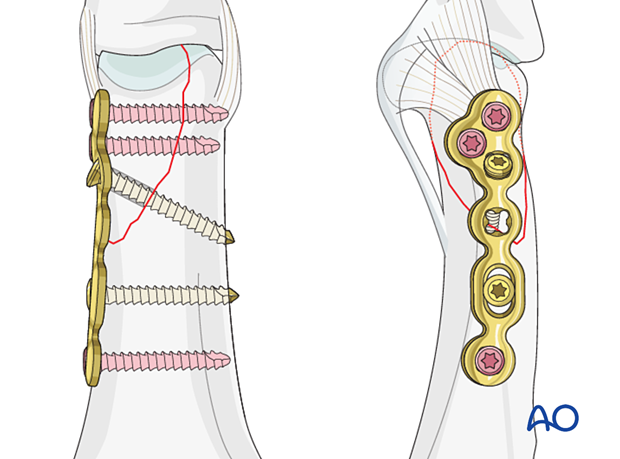
Anatomical reduction mandatory
Articular fractures must be reduced anatomically. Otherwise, the articular cartilage may be damaged, leading to painful degenerative joint disease and digital deformity.
This illustration shows how even slight unicondylar depression may lead to angulation of the finger.
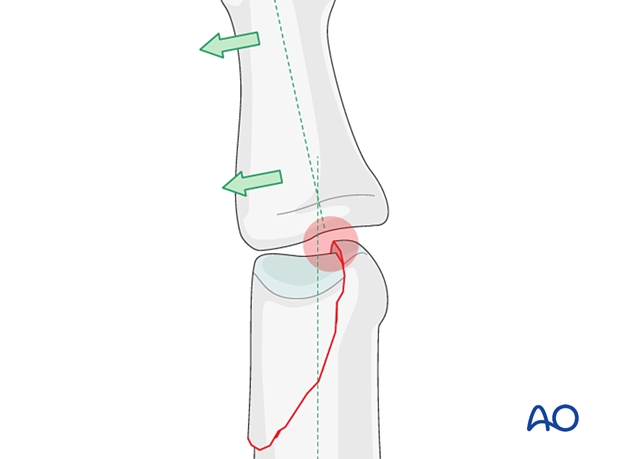
Plate selection
For neutralization or neutralization plating, several plate types may be used:
- Conventional straight locking compression plate (LCP); dorsal or lateral
- T-plate (adaption plate); dorsal
- Strut plate; dorsal
- Phalangeal head plate; lateral
The plates may come with or without variable-angle (VA) locking head screws. If an anatomical plate is not available, a conventional minicondylar plate may be used.
The plate selection depends on the fracture pattern and should allow at least two screws in the proximal and distal main fragments.
In this procedure, extrinsic compression and fixation with VA locking-head screws through a phalangeal head plate is shown.
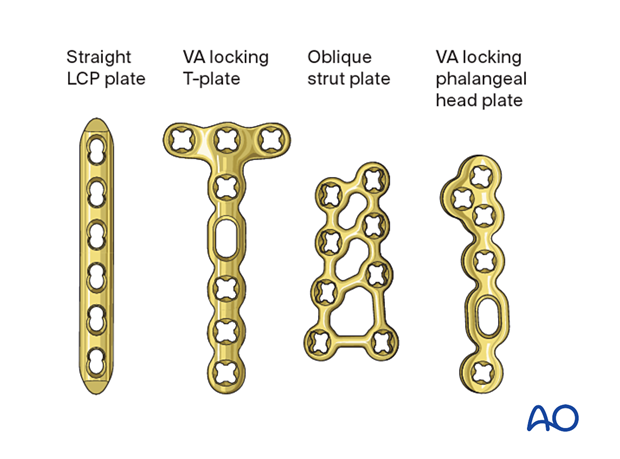
2. Patient preparation
Place the patient supine with the arm on a radiolucent hand table.

3. Approach
For this procedure, a midaxial approach to the proximal phalanx is typically used.
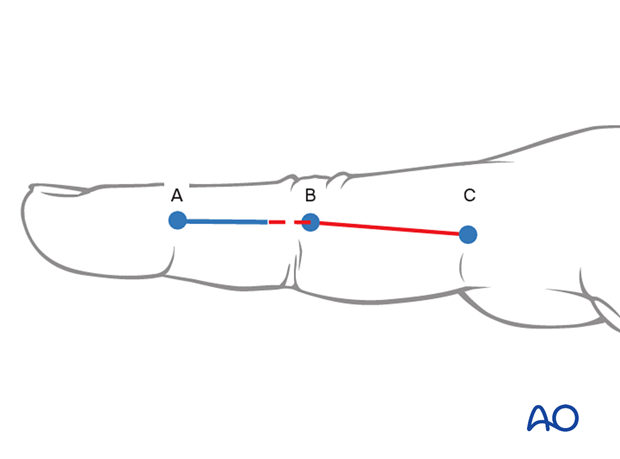
4. Reduction
Reduction by ligamentotaxis
Often, the fracture can be reduced by applying traction via finger traps.
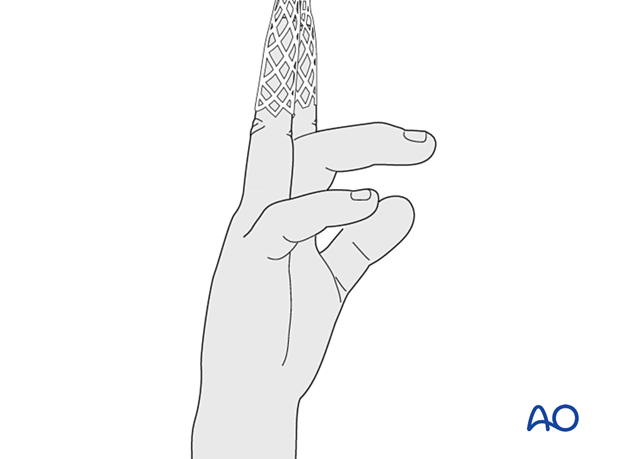
Indirect reduction
Reduction starts with traction to restore length.
Exert lateral pressure with your thumb and index finger or with dedicated percutaneous reduction forceps to reduce the fracture.
Confirm reduction with an image intensifier.
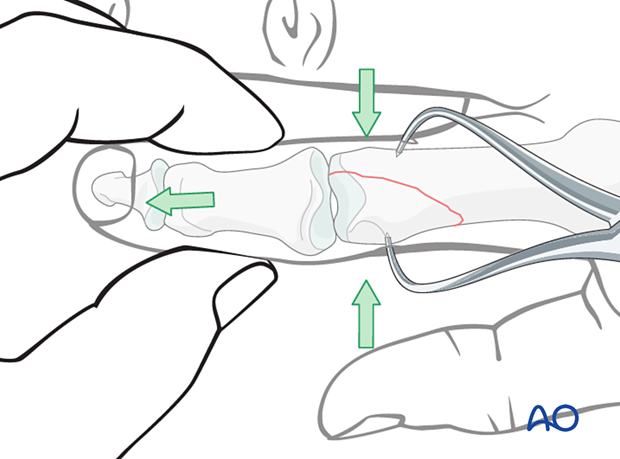
Open reduction
If closed reduction is not successful or in a nonacute case, proceed with an open reduction.
Use a dental pick to gently explore the fracture site to assess its geometry. The pick can also be used carefully to reduce small fragments. Take great care to avoid comminution of any fragment.
It is important to maintain the vascularity of tiny fragments attached to the collateral ligament, to avoid osteonecrosis.
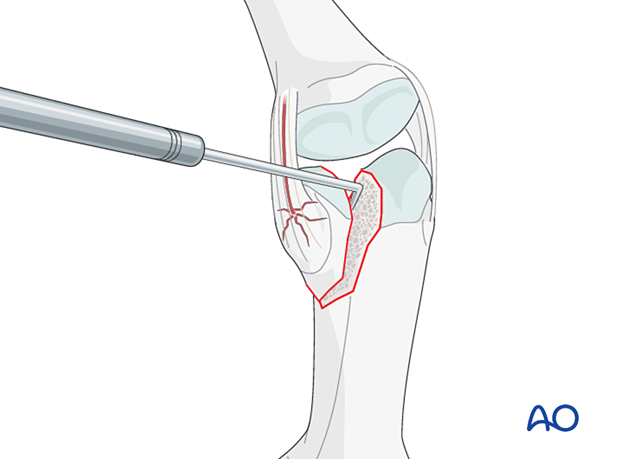
Small pointed reduction forceps can be used for larger fragments gently to rock the fracture from side to side. Be careful not to apply excessive force, which can lead to fragmentation.
Confirm reduction using image intensification.
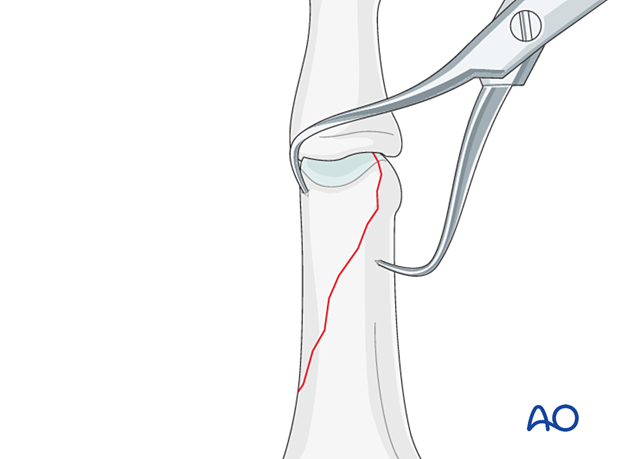
Preliminary K-wire fixation
Insert a preliminary K-wire to stabilize the fracture.
Be careful to place it so it will not conflict with later screw and plate placement.
To avoid conflict of the plate with the insertion of the collateral ligament, the K-wire may be placed in the isometric insertion of the collateral ligament. The notch of the plate may then be aligned to it.
Avoid inserting a K-wire into small fragments, as they are in danger of fragmentation.
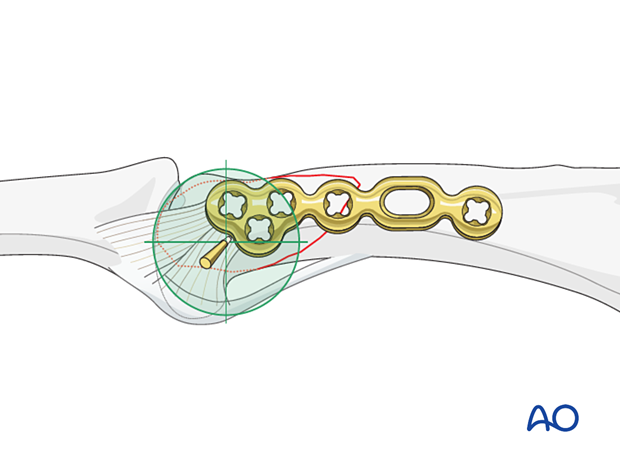
5. Fixation
Lag-screw insertion outside a neutralization plate
If the fracture configuration and plate allow, a lag screw may be inserted outside of the neutralization plate.
The lag screw should be inserted centered on and as perpendicularly to the fracture plane as possible and from the dorsal surface. The direction of the obliquity of the fracture plane dictates the exact position of the lag screw.
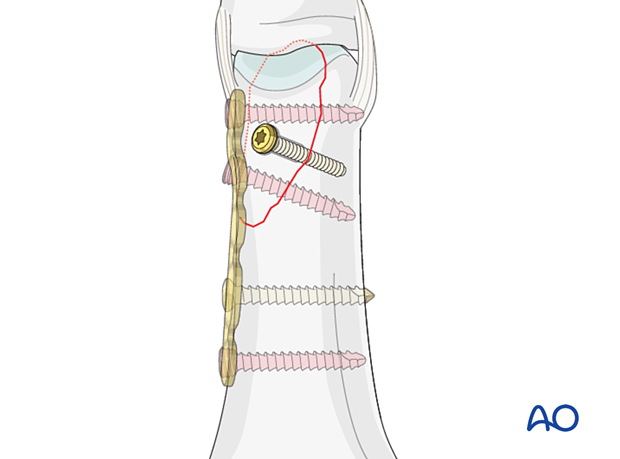
Screw size selection
The exact size of the diameter of the screws used will be determined by the fragment size and the fracture configuration.
The various gliding and thread hole drill sizes for different screws are illustrated here.

Pitfall: countersinking

Screw length pitfalls
- Too short screws do not have enough threads to engage the cortex properly. This problem increases when self-tapping screws are used due to the geometry of their tip.
- Too long screws endanger the soft tissues, especially tendons and neurovascular structures. With self-tapping screws, the cutting flutes are especially dangerous, and great care has to be taken that the flutes do not protrude beyond the cortical surface.

6. Plate fixation
Neutralization plate
Apply the neutralization plate depending on the fracture plane and the lag-screw position, either dorsally or laterally.
Insert at least two screws proximally and distally to the fracture in neutral mode.
Plate trimming
Adapt the plate length to fit the length of the proximal phalanx. Avoid sharp edges, which may be injurious to the tendons. There should be at least 3 plate holes proximal to the fracture available for fixation in the diaphysis. At least two screws need to be inserted into the diaphysis.
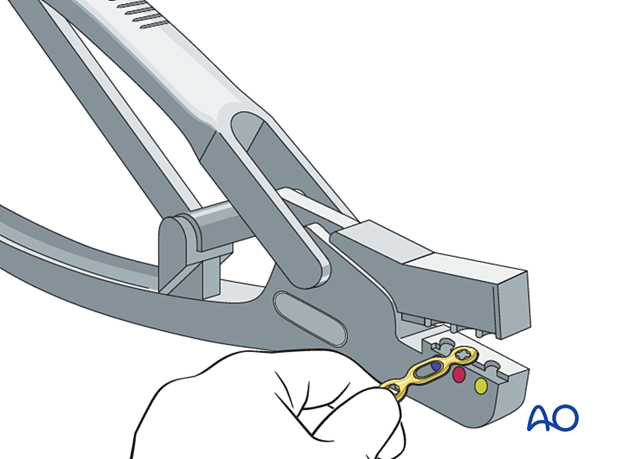
Plate positioning
Place the plate slightly dorsal to the midaxial line of the bone, allowing at least two screws in the distal fragment.
The plate notch should be aligned to the K-wire in the isometric insertion of the collateral ligaments.
Keep the plate in place with the atraumatic forceps.

Screw insertion
Start with insertion of a cortical screw in the oblong whole. This will allow for further adjustment of the plate.
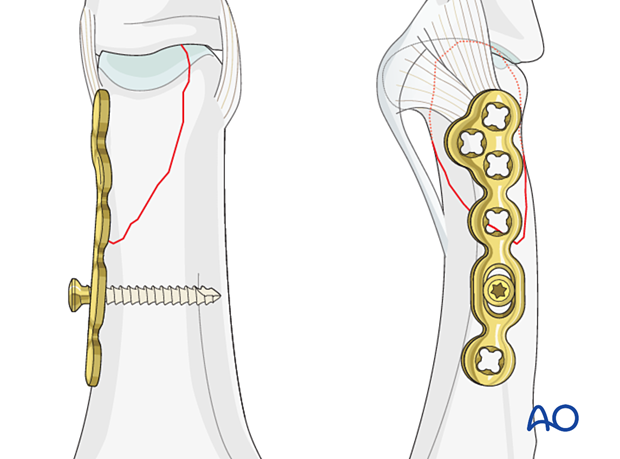
Fracture compression
The fracture may be compressed with lag screw(s) through the plate if cortical screws are used.
When using an anatomical plate and VA locking-head screws, apply extrinsic compression with reduction forceps and hold it by inserting the locking-head screw(s) in the articular block.
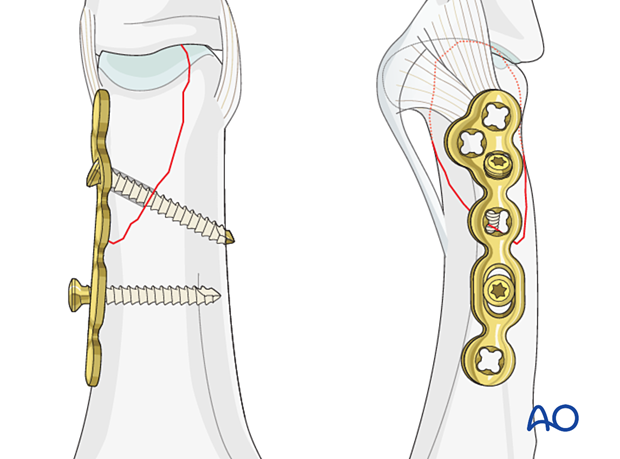
Finalizing plate fixation
Insert further screws through the other plate holes.
Insert at least two screws in the articular block first. Take care not to violate the joint surface.
Finalize the plate fixation with introduction of the remaining screw(s).
Cover the plate with periosteum to avoid adhesion between the tendon and the implant leading to limited finger movement.

7. Final assessment
Confirm fracture reduction and stability and implant position with an image intensifier.
8. Aftercare
Postoperative phases
The aftercare can be divided into four phases of healing:
- Inflammatory phase (week 1–3)
- Early repair phase (week 4–6)
- Late repair and early tissue remodeling phase (week 7–12)
- Remodeling and reintegration phase (week 13 onwards)
Full details on each phase can be found here.
Postoperative treatment
If there is swelling, the hand is supported with a dorsal splint for a week. This would allow for finger movement and help with pain and edema control. The arm should be actively elevated to help reduce the swelling.
The hand should be splinted in an intrinsic plus (Edinburgh) position:
- Neutral wrist position or up to 15° extension
- MCP joint in 90° flexion
- PIP joint in extension
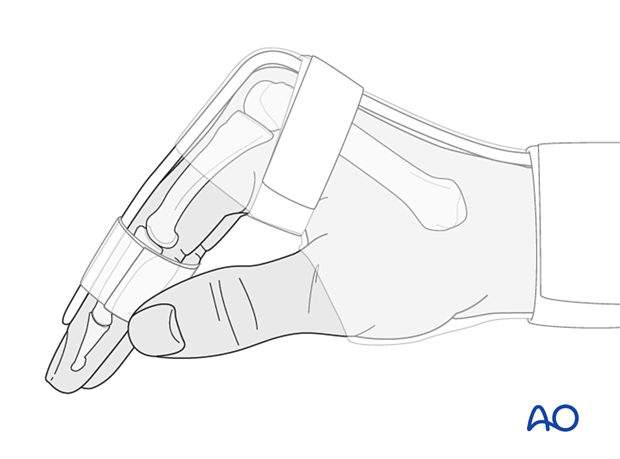
The reason for splinting the MCP joint in flexion is to maintain its collateral ligament at maximal length, avoiding scar contraction.
PIP joint extension in this position also maintains the length of the volar plate.
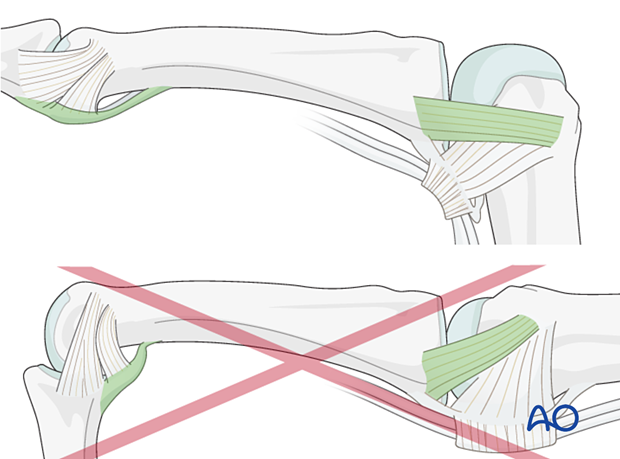
After subsided swelling, protect the digit with buddy strapping to a neighboring finger to neutralize lateral forces on the finger.
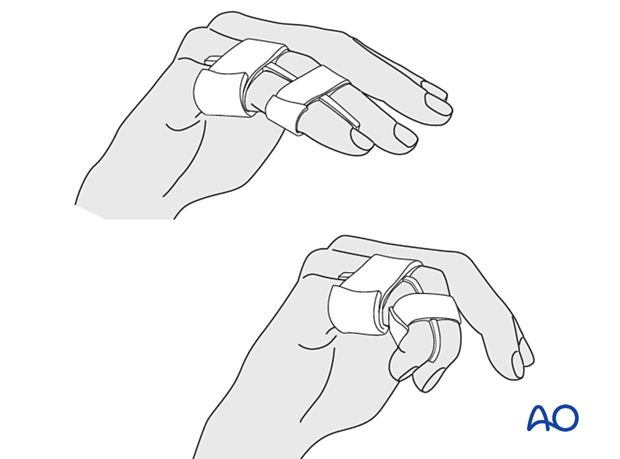
Functional exercises
To prevent joint stiffness, the patient should be instructed to begin active motion (flexion and extension) immediately after surgery.
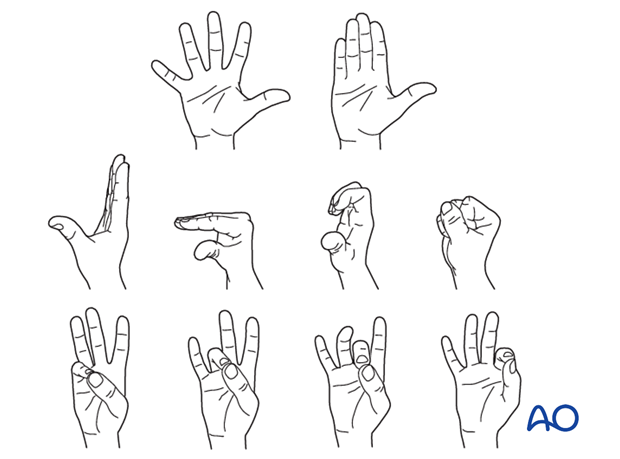
Follow-up
See the patient after 5 and 10 days of surgery.
Implant removal
The implants may need to be removed in cases of soft-tissue irritation.
In case of joint stiffness or tendon adhesion restricting finger movement, arthrolysis or tenolysis may become necessary. In these circumstances, the implants can be removed at the same time.













